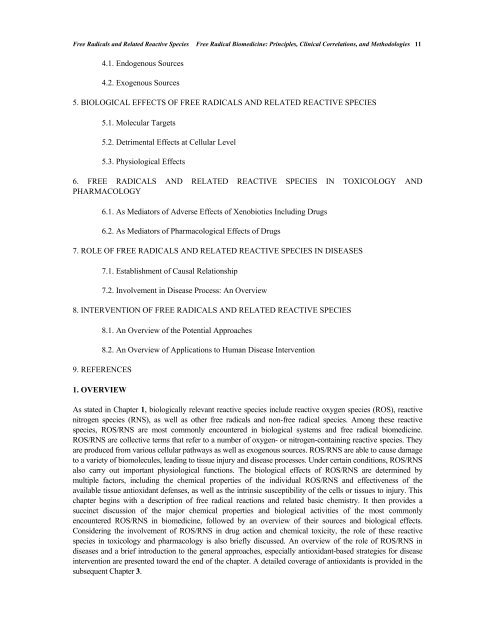Free Radical Biomedicine: Principles, Clinical ... - Bentham Science
Free Radical Biomedicine: Principles, Clinical ... - Bentham Science
Free Radical Biomedicine: Principles, Clinical ... - Bentham Science
You also want an ePaper? Increase the reach of your titles
YUMPU automatically turns print PDFs into web optimized ePapers that Google loves.
<strong>Free</strong> <strong>Radical</strong>s and Related Reactive Species <strong>Free</strong> <strong>Radical</strong> <strong>Biomedicine</strong>: <strong>Principles</strong>, <strong>Clinical</strong> Correlations, and Methodologies 11<br />
4.1. Endogenous Sources<br />
4.2. Exogenous Sources<br />
5. BIOLOGICAL EFFECTS OF FREE RADICALS AND RELATED REACTIVE SPECIES<br />
5.1. Molecular Targets<br />
5.2. Detrimental Effects at Cellular Level<br />
5.3. Physiological Effects<br />
6. FREE RADICALS AND RELATED REACTIVE SPECIES IN TOXICOLOGY AND<br />
PHARMACOLOGY<br />
6.1. As Mediators of Adverse Effects of Xenobiotics Including Drugs<br />
6.2. As Mediators of Pharmacological Effects of Drugs<br />
7. ROLE OF FREE RADICALS AND RELATED REACTIVE SPECIES IN DISEASES<br />
7.1. Establishment of Causal Relationship<br />
7.2. Involvement in Disease Process: An Overview<br />
8. INTERVENTION OF FREE RADICALS AND RELATED REACTIVE SPECIES<br />
8.1. An Overview of the Potential Approaches<br />
8.2. An Overview of Applications to Human Disease Intervention<br />
9. REFERENCES<br />
1. OVERVIEW<br />
As stated in Chapter 1, biologically relevant reactive species include reactive oxygen species (ROS), reactive<br />
nitrogen species (RNS), as well as other free radicals and non-free radical species. Among these reactive<br />
species, ROS/RNS are most commonly encountered in biological systems and free radical biomedicine.<br />
ROS/RNS are collective terms that refer to a number of oxygen- or nitrogen-containing reactive species. They<br />
are produced from various cellular pathways as well as exogenous sources. ROS/RNS are able to cause damage<br />
to a variety of biomolecules, leading to tissue injury and disease processes. Under certain conditions, ROS/RNS<br />
also carry out important physiological functions. The biological effects of ROS/RNS are determined by<br />
multiple factors, including the chemical properties of the individual ROS/RNS and effectiveness of the<br />
available tissue antioxidant defenses, as well as the intrinsic susceptibility of the cells or tissues to injury. This<br />
chapter begins with a description of free radical reactions and related basic chemistry. It then provides a<br />
succinct discussion of the major chemical properties and biological activities of the most commonly<br />
encountered ROS/RNS in biomedicine, followed by an overview of their sources and biological effects.<br />
Considering the involvement of ROS/RNS in drug action and chemical toxicity, the role of these reactive<br />
species in toxicology and pharmacology is also briefly discussed. An overview of the role of ROS/RNS in<br />
diseases and a brief introduction to the general approaches, especially antioxidant-based strategies for disease<br />
intervention are presented toward the end of the chapter. A detailed coverage of antioxidants is provided in the<br />
subsequent Chapter 3.

















